
Vijayadashami, more commonly known as Dassahra in Hindi-Urdu, and also known as Dashāhra or Dashain in Bhojpuri, Maithili and Nepali, is a major Hindu festival celebrated every year at the end of Durga Puja and Navarahtri. It is observed on the tenth day of the month of Ashvin, the seventh in the Hindu lunisolar calendar. The festival typically falls in the Gregorian calendar months of September and October, more specifically between 27 September and 26 October. It is celebrated on the tenth day of the waxing moon of the Ashvayuja month.

The Gondi (Gōṇḍī) or Gond people, who refer to themselves as "Kōītōr", are an ethnolinguistic group in India. Their native language, Gondi, belongs to the Dravidian family. They are spread over the states of Madhya Pradesh, Maharashtra, Chhattisgarh, Uttar Pradesh, Telangana, Andhra Pradesh, Bihar, and Odisha. They are listed as a Scheduled Tribe for the purpose of India's system of reservation.

Bastar is a district in the state of Chhattisgarh in Central India. Jagdalpur is the district headquarters. Bastar is bounded on the northwest by Narayanpur District, on the north by Kondagaon district, on the east by Nabarangpur and Koraput Districts of Odisha State, on the south and southwest by Dantewada and Sukma. The district possesses a unique blend of tribal and Odia culture.
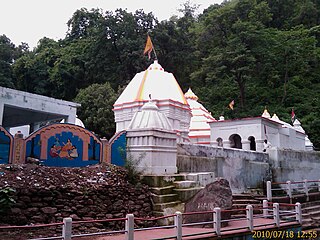
Balangir District, also called Bolangir District, is a district situated in Odisha state of India. The district has an area of 6,575 km2 (2,539 sq mi), and a population of 1,648,997. The town of Balangir is the district headquarters. The composition of the land is predominantly rural. Other important towns in Balangir district are Titlagarh, Patnagarh, Kantabanji, Loisingha, Saintala, Belpada, Tushra, Agalpur, Deogaon, Chudapali, Biripali, Bhalumunda, Bangomunda, Sindhekela, Kansil, Turekela and Muribahal.

Uttar Bastar Kanker District is located in the southern region of the state of Chhattisgarh, India within the latitudes 20.6-20.24 and longitudes 80.48-81.48. The total area of the district is 6432 square kilometers. The population is 748,941.

Mysore Dasara is the state festival in the state of Karnataka in India. It is a 10-day festival, starting with nine nights called Navaratri and the last day being Vijayadashami. The festival is observed on the tenth day in the Hindu calendar month of Ashvina, which typically falls in the Gregorian months of September and October.
Swarna Gauri Vrata, also called Gauri Habba is a Hindu festival celebrated a day before Ganesh Chaturthi in Karnataka.

Sarkaradevi Temple is one of the most important temples in South India. It is situated Chirayinkeezhu town in Thiruvananthapuram district. Tradition accords a remote antiquity to this temple. Its main deity is Bhadrakali. The Sarkaradevi Temple assumed a significant status for many reasons and rose to historical importance mainly with the introduction of the famous Kaliyoot festival by Anizham Thirunal Marthanda Varma, the Travancore sovereign, in 1748. The Sarkaradevi Temple have some basic attachment with Nakramcode Devi Temple which located in Avanavanchery, Attingal.
This article lists the traditional festivals and other cultural events in the Odisha region of India. Odisha celebrates 13 festivals in 12 months as the saying goes Bāra Māsare Tera Parba.

Nuakhai is an agricultural festival mainly observed by people of Western Odisha in India. Nuakhai is observed to welcome the new rice of the season. According to the calendar it is observed on panchami tithi of the lunar fortnight of the month of Bhadrapada or Bhadraba (August–September), the day after the Ganesh Chaturthi festival. This is the most important social festival of Western Odisha and Chhattishgarh also adjoining areas of Simdega in Jharkhand, where the culture of Western Odisha is much predominant.

Bhunjias, are an ethnic group found in India mainly reside in Sunabeda plateau in Odisha and Chhattisgarh. They are mostly found in Nuapada district, which is roughly between 22° 55′ N and 21° 30′ N latitude and 82° 35′ E longitude. It was a part of Khariar Zamindari, which formed the eastern and the southeastern region of Raipur district of Chhattisgarh division in Central Province till 1 April 1936, when it was transferred to Odisha on its creation. It is now in Komna block of Nuapada district in Orissa. In Chhattisgarh they are found in Raipur district.
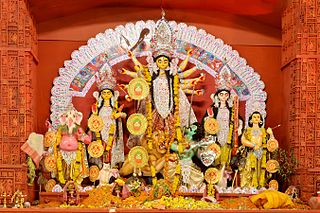
Ayudha Puja is a Hindu observance that falls on the ninth day of the bright half of the moon's cycle of 15 days in the month of September/October, popularly a part of the Navaratri festival. While the Navaratri festival is observed all over the country, the festivity that is widely marked as Ayudha Puja possesses slight variations of veneration and practices across India.
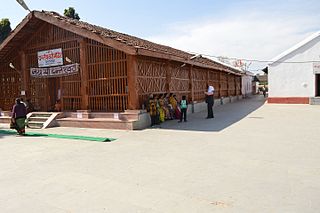
Danteshwari Temple is Hindu temple, dedicated to Goddess Danteshwari, and is one of the 52 Shakti Peethas, shrines of Shakti, the divine feminine, spread across India. The temple built in the 14th century, is situated in Dantewada, a town situated 80 km from Jagdalpur Tehsil, Chhattisgarh. Dantewada is named after the Goddess Danteshwari, the presiding deity of the earlier Kakatiya rulers. Traditionally she is the Kuldevi of Bastar state,
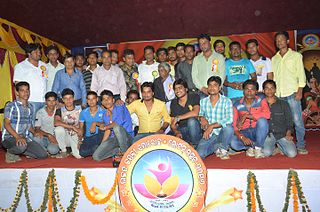
Olash is a coastal village in Jagatsinghpur district of Odisha, India. It is a village having a population of about 1000 people, and is located about 30 km from the district town of Jagatsinghpur on the Cuttack–Naharana road, about 5 km from the Bay of Bengal to the east. The village is known for paddy and Chilly cultivation.
Haragapur is a village in Belgaum district in the southern state of Karnataka, India. It is attached to NH-4. Places to visit are Shivaji Fort, Mallikarjun Temple & Navanath Mandir. Village is located on Hilltop. Language spoken here is [[Kannada] [Marathi]]
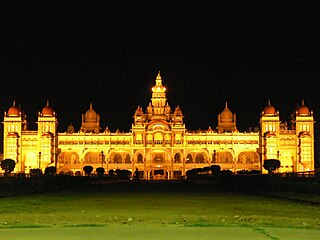
The Mysore Dasara 2013 is the 403rd edition of the annual royal festive gala event, a show of pomp and tradition that is held in the Mysore city in Karnataka, India for 10 days. The festival is called the Navaratri (meaning nine nights or Dussehra or Vijayadashami which conforms to the bright half of the month of Ashvin, from pratipadathithi to navamithithi in the Hindu calendar corresponding to 5 to 13 October during 2013. The festival is also called Nada Habba in Kannada language. The first day of the nine-day festivity started on 5 October with the traditional and religious special puja performed to Goddess Chamundeshwari in the Chamundi Temple on top of the Chamundi Hill, which forms the backdrop to the city; the temple was beautifully decorated with flowers and tourist from Gujarat, Rajasthan and other states enthralled the audience with their bhajan singing. On this occasion, floral tribute wa offered to the goddess by Jnanpith Award winner Chandrashekhara Kambara and festivities will continue for ten days. The ninth day of the festival is a special event called the Mahanavami when the royal sword is worshipped and taken in a procession of elephants, camels and horses. The festival concludes on 14 October on the dashami day with the grand finale of Jambusavari with the idol of Chamundeshawri set in a golden howdah mounted on a richly caparisoned elephant. The procession is taken through the streets of the city and ends in the Banni Mantap where, in the evening, a torch light parade is held. Symbolically, the festival represents the victory of good over evil.
Bastar Lokotsav is a festival of Chhattisgarh that involves the representation of the folk culture of the state of Chhattisgarh. The lokotsav, which occurs after the end of rainy season, attracts large number of tribal groups who come to participate in this festival from remote villages of Chhattisgarh. Handicraft items are exhibited in the Bastar Lokotsav. Connoting the festival of the folk people of Chhattisgarh, lokotsav of Bastar starts with an array of cultural events. The Jagadalpur area of Chhattisgarh organizes a special program called BastaParab in which dance and song variations of the tribal communities can be seen.
Madai festival is one of many popular festivals of Sanskritik Chhattisgarh. The festival reflects the rich culture and tradition of the state. The Madai Festival is celebrated with great enthusiasm and excitement by people belonging to the Gond Tribe. It is celebrated from the month of December to March and tours from one place of the state to another. The Charama and Kurna communities of Kanker district, tribes of Bastar and people of Bhanupratappur, Narayanpur, Kondagaon, Pakhanjore and Antagrah celebrate the Madai Festival in the state of Chhattisgarh.
Chhattisgarh embraces a diverse cultural and traditional practices in India. As the state government has taken meticulous steps to preserve the tribal culture, these festivals and the traditions are celebrated almost from the time of ancient India.
The Bastar Rebellion, also known as the Bhumkal Movement was an Adivasi rebellion in 1910 against the British Raj in the princely state of Bastar in central India. It was primarily led by Gunda Dhur, a tribal leader, as well as by a diwan and cousin of the king, Lal Karendra Singh. The tribals mobilized, which led to the entire state rising in revolt against the British colonial government, overwhelming the small 250-strong police force in the state, and was marked by widespread rioting, looting and arson. By the end of February, however, additional troops from neighbouring Jeypore and Bengal had quelled the revolt and arrested the leaders.













